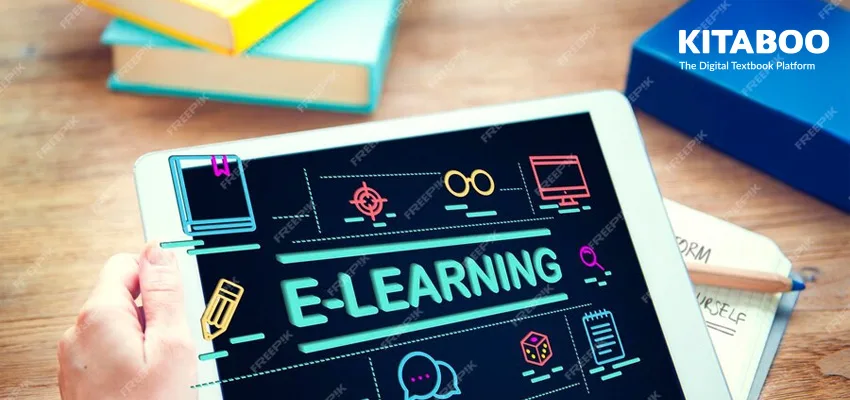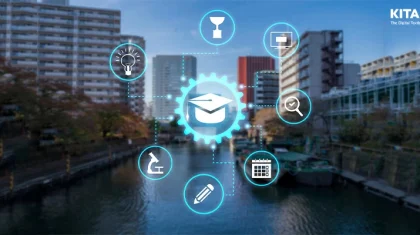
Top eLearning Solutions for Higher Education: A Comprehensive Guide
Summarize this blog with your favorite AI:
The educational system is transforming as higher education eLearning solutions and higher education technology become more widely embraced. These digital tools make learning more interesting, adaptable, and efficient, allowing schools to respond to an ever-changing academic world.
According to statistics, the market for online learning platforms will be worth an astonishing US$60.25bn by 2025.
With more students opting for online or hybrid education, higher education institutions need to embrace digital classroom solutions that improve content delivery, increase student engagement, and give vital performance analytics.
This article looks at some of the most efficient eLearning solutions in higher education, outlining their essential features, benefits, and profound impact on contemporary learning.
Table of Contents:
I. Important Features of a Successful eLearning Solution
II. Best eLearning Technologies for Higher Learning
- Learning Management System (LMS)
- Digital Textbook Platform
- Virtual Labs and Simulations
- Video-Based Learning Platforms
- AI-Powered, Dynamic Educational Technologies
III. Advantages of eLearning Solutions in Higher Learning
IV. How to Select the Ideal eLearning Solution
V. Difficulties in Applying eLearning Solutions
VI. The Next Generation of eLearning in Higher Learning
VII. Real-Life eLearning Solutions Implementations in Educational Institutions
VIII. Conclusion
Important Features of a Successful eLearning Solution
To offer a great learning experience, the higher education eLearning solutions should include:
- Simple & Intuitive Design: A simple interface lets teachers and students focus on teaching and learning, respectively, without having to waste time figuring out how the technology works
- Learn Anytime, Anywhere: Complete access on smartphones, tablets, and various other gadgets, making learning easier and more adaptable.
- Personalized Learning Journeys: AI optimizes each student’s success, creating an individualized environment that fosters personal development.
- Smart Insights & Tracking: Receive concise, data-driven statistics on student participation, development, and academic patterns.
- Seamless System Integration: Works seamlessly with university systems such as ERP and SIS, providing an effortless user experience.
- Engaging & Interactive Learning: Gamified components, questionnaires, and group discussions keep learners interested and engaged.
- Secure & Reliable Cloud Storage: Access educational materials anytime with the confidence that your data is safe.
Best eLearning Technologies for Higher Learning
Let’s take a look at the top higher education technology being used today:
1. Learning Management Systems (LMS)
LMS platforms form the backbone of eLearning platforms, making it easy to organize course materials, track assignments, and facilitate student interactions—all in one place.
Top LMS for Higher Education:
- Moodle: A versatile, free-to-use framework that is used extensively and readily adaptive to varying learning requirements.
- Canvas: An accessible cloud-based solution that can expand with institutions of any size.
- Blackboard: Packed with advanced analytics, communication tools, and seamless integration options for a comprehensive learning experience.
2. Digital Textbook Platforms
Digital textbooks bring education to life with compelling multimedia material such as infographics, photos, and immersive quizzes, making learning more exciting and pleasurable.
Best Digital Textbook Platforms:
- KITABOO: The leading AI-driven, cloud-based digital textbook platform for interactive eTextbooks and more.
- VitalSource: Offers eBooks with study tools and offline access.
- RedShelf: Offers low-cost digital textbooks that include analytics tools.
3. Virtual Labs and Simulations
Virtual labs bring STEM instruction to life by replicating actual tests, allowing learners to gain practical training at all times, anywhere.
Leading Virtual Lab Platforms:
- Labster: 3D interactive science simulations.
- Beyond Labz: Virtual experiments for physics, chemistry, and biology.
4. Video-Based Learning Platforms
Video material makes learning more interesting and readily available to students.
Top Video Learning Platforms:
- Coursera for Campus: University-led online courses.
- EdX: Massive open online courses (MOOCs) with certification.
- Panopto: Lecture capture and video management for institutions.
5. AI-Powered, Dynamic Educational Technologies
AI-powered systems customize educational tasks for every student.
Best Adaptive Learning Tools:
- Knewton Alta: AI-powered personalized learning.
- Smart Sparrow: Adaptive learning paths based on student responses.
Advantages of eLearning Solutions in Higher Learning
So, what are the benefits of eLearning platforms?
- Easily Accessible: Students have unlimited access to educational resources whenever they need them.
- Personalized Learning Experiences: AI studies the behavior of students and accordingly adjusts to their needs
- More Learning, Less Cost: Digital education reduces the need for physical materials, making learning more affordable.
- Data-Driven Insights: Educators can monitor student participation and tweak content.
- Sustained Growth: Educational institutions can support a growing student body with no infrastructural restrictions.
How to Select the Ideal eLearning Solution
When selecting the appropriate digital solution, educational institutions should be mindful of these important factors:
- Scalability: Does the platform have the capacity to meet the demands of your university or school and help you expand in the future?
- Seamless Integration: Does it work smoothly with your existing university systems?
- Budget-Friendly: Is it cost-effective while still meeting your institution’s needs?
- Support & Training: Is reliable customer support available when educators and students need help?
- Data Security & Compliance: Does it meet privacy standards like GDPR to keep student information safe?
Difficulties in Applying eLearning Solutions
Despite the advantages, institutions may encounter obstacles such as:
- Digital Divide: Not all students have the luxury of fast internet connections and gadgets.
- Resistance to Change: Educators may need certification on how to use modern technology.
- Content Development: Designing advanced e-courses not only requires effort but also deep knowledge.
- System Integration: Ensuring interoperability with pre-existent systems can be challenging.
Universities and schools, with the use of AI-powered platforms like KITABOO, can cater to these problems and also improve digital education.
The Next Generation of eLearning in Higher Learning
Trends influencing the near future of higher education technology involve:
- AI & Machine Learning: Tailored learning experiences.
- Augmented & Virtual Reality (AR/VR): Realistic simulations facilitate experiential education.
- Blockchain for Credentialing: Secure storage of digital degrees and certificates.
- Microlearning & Bite-Sized Content: Short, engaging lessons for better retention.
- 5G & Cloud-Based Learning: Improved availability of internet resources and enhanced collaboration.
Technology is evolving with each passing day, and to survive in this competitive market, educational institutions should focus on the latest higher education eLearning solutions to revolutionize learning techniques
Real-Life eLearning Solutions Implementations in Educational Institutions
Educational institutions are embracing hybrid learning models, blending in-person classes with digital classroom solutions to create a more flexible and engaging learning experience.
Take Stanford University, for example—they’ve integrated virtual labs and AR/VR simulations into their medical and engineering programs. This allows students to practice complex procedures in a safe virtual setting before applying their skills in real-life scenarios.
Similarly, the University of Oxford has been testing AI-powered evaluation technologies to automate grading and provide instant feedback. This saves a lot of time for teachers as well as enhances students’ productivity.
These days, working from home has become a lot simpler with the invention of web-based tools such as Microsoft Teams, Google Classroom, and Zoom.
At the University of Sydney, an AI-powered chat room automatically connects students who have similar questions or academic interests, making peer communication more meaningful and enriching the overall learning experience.
Conclusion
The upcoming generation of learning is digital. Higher education eLearning solutions have become essential for institutions to stay profitable, increase student involvement, and enhance their educational results.
From AI-powered adaptable educational structures to online learning tools, educational institutions may use technology to create more tailored and effective educational experiences for students.
Academic institutions that use a feature-packed digital textbook and eLearning platform like KITABOO may provide effortless learning, optimize educational tactics, and boost academic performance globally.
Are you ready to transform academic achievement with cutting-edge technology?
Request a demo today!
Also Check:
Discover how a mobile-first training platform can help your organization.
KITABOO is a cloud-based platform to create, deliver & track mobile-first interactive training content.



![Top 5 Free Publishing Sites for Independent Publishing [2026]](https://kitaboo.com/wp-content/uploads/2025/09/Top-5-Free-Publishing-Sites-for-Independent-Publishing-2026-420x235.webp)